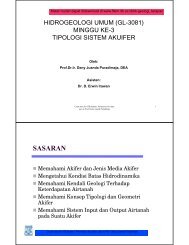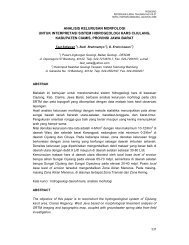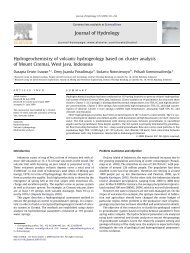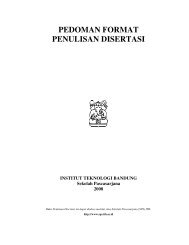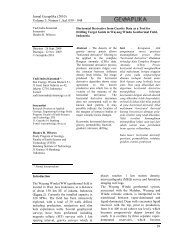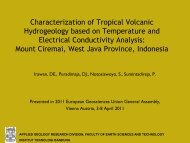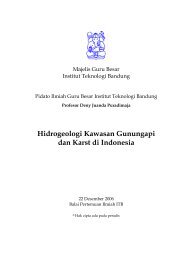Jurnal Geoaplika (2010) Volume 5, Nomor 1, hal. 049 â 059 49 - ITB
Jurnal Geoaplika (2010) Volume 5, Nomor 1, hal. 049 â 059 49 - ITB
Jurnal Geoaplika (2010) Volume 5, Nomor 1, hal. 049 â 059 49 - ITB
Create successful ePaper yourself
Turn your PDF publications into a flip-book with our unique Google optimized e-Paper software.
Santosa, 1992). River alluvial and coastal<br />
deposit are the youngest deposit forming until<br />
now.<br />
Structural geology found in the study area is E-<br />
W and N-S faults (Sujatmiko and Santosa,<br />
1992). These faults are old, formed likely at<br />
Plio-Pleistocene and have been covered by<br />
Quaternary volcanic deposit.<br />
Surface Manifestations<br />
Resistivity survey of Hochstein (1988)<br />
indicates that the study area is an outflow zone<br />
indicated by low resistivity value along the<br />
Cisolok river. The study also indicates that the<br />
Cisolok and Cisukarame are one geothermal<br />
system that relates each other. The different in<br />
the resistivity value indicates that the Cisolok<br />
area consists of more permeable rocks<br />
compared to the Cisukarame area. This is likely<br />
due to the occurrence of limestone of Citarete<br />
formation below Cisolok.<br />
Geothermal manifestations of Cisolok occur in<br />
the surface as hot springs emerging in the<br />
Cisolok river with temperatures above the<br />
boiling point. This thermal water has neutral<br />
pH. Along the river bank around the hot spring,<br />
there is hydrothermal surface alteration<br />
dominated by silica sinter and travertine.<br />
Another surface manifestation occurs in<br />
Cisukarame, i.e. about 6 km north of Cisolok<br />
(Sujatmiko and Santosa, 1992). Based on<br />
resistivity survey of Hochstein (1988), these all<br />
manifestations are a geothermal system having<br />
one similar reservoir and likely relate to<br />
volcanic activity of Gunung Halimun or Salak.<br />
Hot spring<br />
At least there are 6 hot springs discharging<br />
continuously in Cisolok river (Figure 2).<br />
Hochstein (1994) named this manifestation as<br />
spouting springs that occur under artesian<br />
condition. Cisolok thermal water has<br />
temperature of between 90 and 100C, pH of<br />
about 8 and very high flow rate. The<br />
discharging thermal water then mixes with<br />
stream water having temperature of about 28C<br />
and forms a 34C mixed water. One of six hot<br />
springs in Cisolok has been collected in a pond.<br />
The water samples were taken at CSL-01, i.e.<br />
the northern most hot spring in Cisolok river,<br />
and the pond hot water of CSL-07.<br />
Figure 2. Geological traverse along the geothermal surface manifestation of Cisolok.<br />
51





